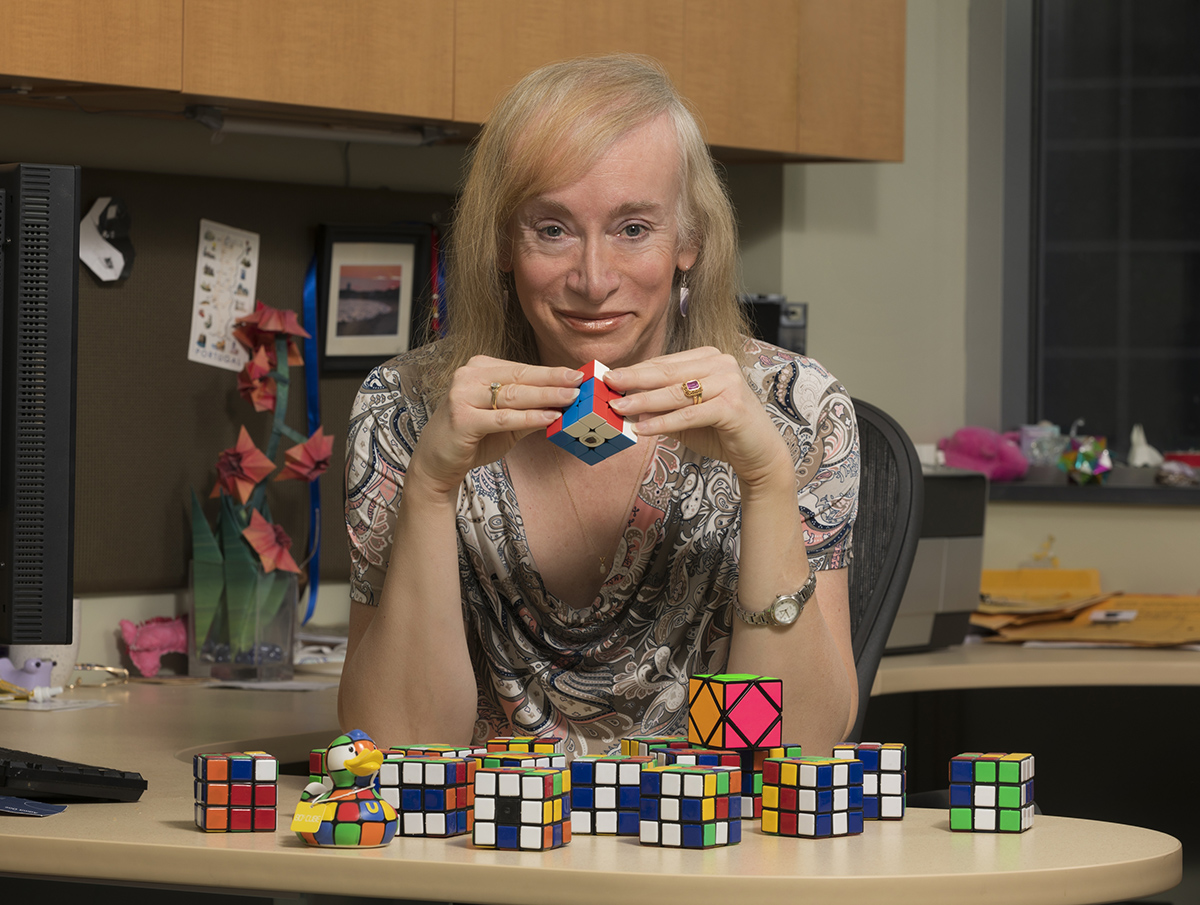Watson professor known as puzzle-solving pioneer
Method to solve to Rubik’s Cube adopted by 'speed-cubers' around the world

In the world of speed cubing — where fleet-fingered competitors solve a Rubik’s Cube in a matter of seconds — two names are revered above all others.
The first, of course, is Erno Rubik, the Hungarian sculptor and architecture professor who invented the iconic puzzle widely considered to be history’s bestselling toy.
The other is Jessica Fridrich, PhD ’95, whose solution for the cube — referred to as the “Fridrich method” — contributed to a revival of interest in the colorful conundrum in the early 2000s.
Fridrich, a distinguished professor of electrical and computer engineering in the Thomas J. Watson College of Engineering and Applied Science, traces her superstar status to 1997, when interest in the cube seemed to be at a low ebb compared to its early 1980s heyday.
She posted her technique for solving it on an online discussion forum called Cube Lovers, and then later on a webpage of her own. The easy-to-remember, four-step process became popular when cube enthusiasts around the globe found each other on the internet.
Even Fridrich is surprised about speed cubers elevating her eponymous method to the heights it’s reached: “Why is Windows the most popular operating system? Maybe not because it’s the best, but because it was one of the first. I also think it’s a very good method — very intuitive. It just works and allows you to solve the cube really fast.”
‘Completely consumed’
Fridrich first became fascinated by the cube at age 17 in 1981, as she finished up high school in her native Czechoslovakia. Even before she owned one, she read about it and started to develop her system to solve it.
“I was mesmerized by it,” she says. “How does it work inside? How can you turn every side and it still holds together? How do you solve it? It’s a challenge. It’s one of the few puzzles where you don’t have to tell anyone any rules. You take the cube, mix it up and everybody knows what their task is. You actually formulate your own rules.”
Behind the Iron Curtain of Soviet economic control, though, getting her hands on the toy proved difficult. So she and her parents traveled to Hungary to find it.
“We bought one from a street vendor,” she says. “It was only semi-legal — we bought a newspaper and then asked about the cube. The vendor looked left and right, and then she asked for 125 florins. She handed it to us in a little brown bag. In Austria, you could just walk into a toy shop and get one, but not in the socialist countries.”
She and her friends became “completely consumed” by different algorithms for solving the cube, and in 1982, she won the Czech cubing championship with a time of 23.55 seconds. Later that year, she came in 10th place in the world championship in Budapest at 29.11 seconds — a result she blames in part on the hard-to-turn cubes given to competitors.
The cube craze faded soon after — the next world championship would not be held until 2003, in Toronto, where Fridrich came in second place and one of her apprentices, Dan Knights, finished first. (Her average time was 20.48 seconds, while his was 20 seconds.) Since then, the competition has been held every other year in cities such as Bangkok, Las Vegas, Paris and Melbourne.
Times to solve the cube have become progressively faster, with the world record at 3.5 seconds and the average speed at 5.7 seconds. Fridrich credits better engineering inside the newer toys, which allows for quicker and more accurate twisting. Still, witnessing today’s best speed cubers looks like something akin to magic.
Coming to America
After earning math degrees in Czechoslovakia, Fridrich arrived at Binghamton for a PhD in systems science. She became fascinated by the emerging field of digital steganography — hiding messages in media files — and spent 10 years at the University as a research scientist and research faculty member. She became a member of the teaching faculty in Watson’s Department of Electrical and Computer Engineering in 2005.
Although her love of the Rubik’s Cube and her study of steganography don’t have much overlap, they share a sense of exploring a new and unknown territory where the only rules are the ones you make up yourself. It’s the same feeling she gets as a scenic photographer, heading into the wilderness searching for the perfect conditions to capture an image like no one else has.
Fridrich still attends speed-cubing championships, and there are videos all over the internet promising to teach the Fridrich method. Fans sometimes send Rubik’s Cubes for her to sign for them, and once in a while she’s recognized in random places for her role in keeping the cube alive.
“I’m incredibly thankful to the cube for teaching me some life lessons,” she says. “It’s taught me that if you want to be really, really good at something, you have to put so much effort into it that it’s insane. You have to be consumed by it. Being on top of the world in any endeavor is an incredible amount of work, and there’s no substitute for it.”

